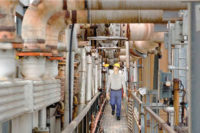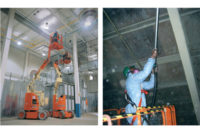Don't take risks with dust hazards
Only qualified persons should manage dust hazards due to explosion risk and liability

Combustible dust hazards are under-recognized in the industry and can pose a significant risk to your employees' safety and the integrity of your facilities. Technological advances in explosion mitigation techniques and equipment have made it possible to reduce the risk and severity of combustible dust-related incidents. These controls are most effective when designed, installed, and maintained by qualified persons.
For new dust collection system installations, safety by design can be achieved by implementing safeguards based on the dust's explosibility characteristics. These include methods to minimize equipment damage, redirect or isolate hazards, or prevent an explosion from occurring.
For new and existing installations, a hazard analysis conducted by a qualified person should be performed to determine the most effective combustible dust hazard mitigation approach.
Loss history
Cloney (2020) revealed that the United States had averaged 31 combustible dust explosion events per year over the last four years. Limited information has been available for damages related to combustible dust fires and explosions, but several have exceeded $1M in losses. The data would suggest a downward trend in 2020. The number of combustible dust fires and explosions in the first half of 2020 is down across the globe, presumably related to shutdowns from the pandemic.
Incidents may begin to rise as industry adapts to the effects of the pandemic and full operational capability resumes.
Operators and management of industrial facilities have a duty of care to understand the common issues and oversight required. Qualified persons well-versed in process safety and combustible dust hazard mitigation are needed to support and maintain continuity from system design, installation, and maintenance.
Vendor selection
As a consumer, you may understandably seek to rely on the manufacturer's expertise in designing a system that will meet operational objectives and compliance requirements.
- How do you know if your dust collection system was designed to comply with applicable combustible dust standards?
- Is the manufacturer of the system an expert in fire and explosion detection, suppression, or control? What about the installation contractor?
- Did it factor in production throughput or changes in your production throughput since installation?
- How do you maintain continuity between design, installation, and preventative maintenance?
Suppose you check the vendor's operation and installation manual regarding owner responsibility and combustible dust hazards. It may expressly state that the manufacturer is neither an expert nor a certified consultant in fire, spark, explosion protection, suppression, or control. There is often a full page of text explaining why they are not responsible for the system's design, operation, or installation.
The final selection of risk mitigation strategies should be based on the outcome of a dust hazards analysis. The implementation of a quality DHA is considered critical.
All too often, combustible dust collection systems are purchased and installed without completing a dust hazards analysis. While the equipment manufacturer may design for a range of applications, they cannot know the conditions specific to your facility, creating risk to life and property.
Safety by design can be achieved and begins with understanding the explosibility characteristics of the dust.

Know your dust
The first step in selecting an appropriate dust collection system is to determine if your dust is explosible.
Reputable dust collection vendors will require explosibility characteristic data to factor into the design of your system. Typically, the first two parameters used in characterizing dust and designing a dust collection system are the Kst and Pmax.
The Kst is a measurement of explosion severity. The higher the Kst value, the stronger the force the dust could generate during an explosion. It is important to note that a low Kst does not mean that the dust is only slightly combustible or nearly noncombustible. It merely tells you how fast an explosion may travel. The OSHA Combustible Dust National Emphasis Program (NEP) categorizes the low range of Kst as a "weak explosion," which only furthers this misnomer in the industry.
For reference, the sugar dust that claimed 14 lives and injured 38 in the Imperial Sugar explosion was a ST1 dust, also categorized as a "weak explosion."
The second test used in your system's design is the Pmax or the maximum amount of pressure that the dust could generate in an enclosed volume.
Knowing this information allows for the system to be designed to manage the expected pressures through passive and active explosion controls and predict its severity. "Failure to provide this information will increase your costs since the supplier will have to use worst-case estimates of the Kst and Pmax values or may even refuse to provide the equipment" (Walters & Supine, 2014).
If your dust collector vendor isn't asking for this information before selling you a system, you should consider a different vendor.
Equipment selection
With the explosibility characteristics of the dust identified, appropriate fire and explosion controls can be selected.
There are many types of devices and systems available to comply with NFPA standards for the explosion protection of dust collection systems. The two general categories of controls are passive and active.
Passive systems do not require detection devices and react in response to deflagration pressure. In contrast, an active system uses a sensor to detect the pressure rise during a deflagration event then activates the respective explosion protection device.
Explosion control
Explosion control can be provided using one or a combination of methods to protect an enclosure from rupture. Passive controls for dust collection systems include deflagration venting and/or flameless venting.
When a dust collector is installed outdoors, deflagration venting to an unoccupied area is permissible. If the dust collector is installed indoors, special consideration needs to be provided to protect occupants.
Flameless venting may be an option to protect occupants from the effects of a deflagration.
Active controls to prevent an explosion in a dust collector are available, including oxidant concentration reduction or chemical suppression. The oxidant concentration reduction method reduces and maintains the system's oxygen concentration below which combustion is not possible.
More commonly used in dust collection systems is chemical suppression. These systems can detect the onset of a deflagration and impending pressure rise within milliseconds and deploy a chemical agent to extinguish the flame before the explosion can happen. This technology can be especially useful when designed and maintained correctly.
Explosion isolation
Once appropriate explosion protection controls have been determined for your vessel or dust collector, the next step is to isolate the hazard. Often the most destructive effects of a dust explosion are caused by flame propagation and pressure piling leading to the potential for a secondary deflagration or explosion. Isolation methods prevent flame and pressure propagation from one part of the system to another.
Passive isolation systems include passive float valves and flow-actuated flap valves. Both provide a mechanical barrier to isolate the pressure and flame front from propagating further through the ducting. These devices can be a cost-effective addition to your mitigation plan.
Suppose the dust collector is recycling makeup air back into the building. In that case, passive isolation devices could be used to protect occupants from the effects of a vented deflagration or fire event in the dust collector.
Active isolation systems typically use pressure or optical sensing devices to monitor conditions and then react by activating an isolation device. These can include chemical suppression, fast-acting knife gates, or high-speed abort gates and can be designed to respond in milliseconds.

System certification
Let's say, for example, you've elected to utilize deflagration venting for your outdoor dust collector and flow-actuated flap valve to provide inlet isolation and protection of upstream processes. Has a recognized third-party organization tested the equipment?
NFPA 69: Explosion Prevention Systems prescribes that the "system design methodology and application range shall be supported by appropriate testing and certified by a recognized testing organization acceptable to the authority having jurisdiction."
This process ensures that the equipment has been tested and proven effective under real-world conditions. Products are being sold on the market today that have not undergone this extensive validation process. Walters and Supine (2012) state, "as an example, sometimes products, such as back flap dampers, may be reverse-engineered by suppliers that do not have any expertise in explosion protection or have chosen not to perform the required testing to satisfy the standards and/or the performance-based provisions."
The value of third-party testing and certification cannot be overstated. A third-party review provides a performance demonstration of the safe application and operation or limitations of your explosion control systems. Application and prescribed design requirements vary depending on the equipment and may include, but not limited to:
- Approved dust types and explosibility characteristic ranges (Kst, Pmax)
- Minimum (Lmin) and maximum (Lmax) location placement distances from the expected ignition source
- Maximum number of flow direction changes
- Detection specification of activation pressure or rate of pressure rise
Let's assume you do the due diligence and purchased validated equipment; who do you have conduct the installation, your local general contractor? Are they well versed in the application and installation requirements of explosion controls?
To be most effective, the installation of explosion controls requires alignment with the performance demonstration criteria.
For new installations, a preliminary design review can be utilized to better understand the extensive NFPA requirements, life safety objectives, and installation requirements. The design and installation of these systems are complex and should be included in your dust hazards analysis.
Failure to conduct a dust hazards analysis is an all too common oversight and can lead to installations with unmitigated risks.
Conclusion
Providing the most appropriate explosion controls and equipment for a process or system handling combustible dust should be evaluated through a hazard analysis for existing installations or a preliminary design review for new facilities.
This process can be conducted internally or by an outside resource but should be performed by a qualified person.
NFPA 652 defines a qualified person as "A person who, by the possession of a recognized degree, certificate, professional standing, or skill, and who, by knowledge, training, and experience, has demonstrated the ability to deal with problems related to the subject matter, the work, or the project."
For a dust hazards analysis or preliminary design review to be effective, it must analyze all the potential fire, deflagration, and explosion scenarios associated with the processes and connected ventilation systems. The hazards associated with combustible dusts are complex.
A qualified individual will have intimate knowledge and specific experience in assessing and mitigating these hazards in various capacities and industries.
Bringing in an outside consultant or engineer prevents bias and conflicts of interest when evaluating these hazards. Additionally, an experienced consultant will bring a fresh perspective and provide insight into industry best practices. Reputable vendor selection and unbiased guidance can help maintain continuity from start to finish.
References
Cloney, Chris (2020). "2020 (Mid-Year) Combustible Dust Incident Report – Version #5"
DustEx Research Ltd. Retrieved from http://dustsafetyscience.com/2020-Report
NFPA 652: Standard on the Fundamentals of Combustible Dust, 2019 edition. National Fire Protection Association, Quincy, MA.
NFPA 69: Standard on Explosion Prevention Systems, 2019 edition. National Fire Protection Association, Quincy, MA.
Occupational Safety and Health Administration (2008). Combustible dust national emphasis program (CPL 03-00-008).
Walters, M., & Supine, T. (2014). Combustible Dust Compliance: Avoiding Common Pitfalls. Occupational Health & Safety. https://ohsonline.com/Articles/2014/03/01/Combustible-Dust-Compliance.aspx?Page=3
Walters, M., & Supine, T. (2012). Combustible Dust: Identifying, Addressing Explosion Risks Can Save Lives. Plant Engineering. https://www.plantengineering.com/articles/combustible-dust-identifying-addressing-explosion-risks-can-save-lives/
Source for chart: OSHA CPL 03-00-008 - Combustible Dust National Emphasis Program
Looking for a reprint of this article?
From high-res PDFs to custom plaques, order your copy today!








